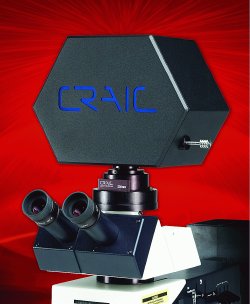Organic Light Emitting Diodes (OLED) are being developed for the next generation of displays and light sources. The QDI 302 microscope spectrophotometer, from CRAIC Technologies, is designed to measure and compare the spectral output, intensity and color consistency of each of the microscopic pixels commonly found in OLED devices.

Organic light emitting diodes (OLED) have an emissive electroluminescent layer that consists of organic molecules in a supporting matrix. For displays, this layer is formed into millions of microscopic pixels in ordered rows and columns. As different organic compounds are used to generate different colors, pixels with different organic compounds can generate different colors for full color, high resolution displays. The biggest advantages of the OLED devices, u nlike the traditional Liquid Crystal Displays (LCD), is that the pixels combine both the light source and the color source. This means that OLED displays are lighter and thinner and use less electricity than an LCD. However, consistency of the intensity and the color of the optical emission across the device is critical. This is where instruments such as the QDI 302 spectrophotometer for microscopes are used.
The QDI 302 is a spectrophotometer that is designed to add to the open photoport of a microscope or probe station. It allows the user to acquire images and acquire spectra of microscopic sample areas quickly and rapidly. When added to the appropriate microscope or probe station, the QDI 302 can be used to measure the color and intensity of each pixel of a OLED display. Pixels can then be compared with one another for consistency or maps of both the intensity and color can be generated for each device. And as instruments such as the QDI 302 can acquire spectra on the order of a few milliseconds, entire OLED displays can be mapped quickly and accurately. This will ensure the consistency of both color and intensity across the entire device as well as from device to device.